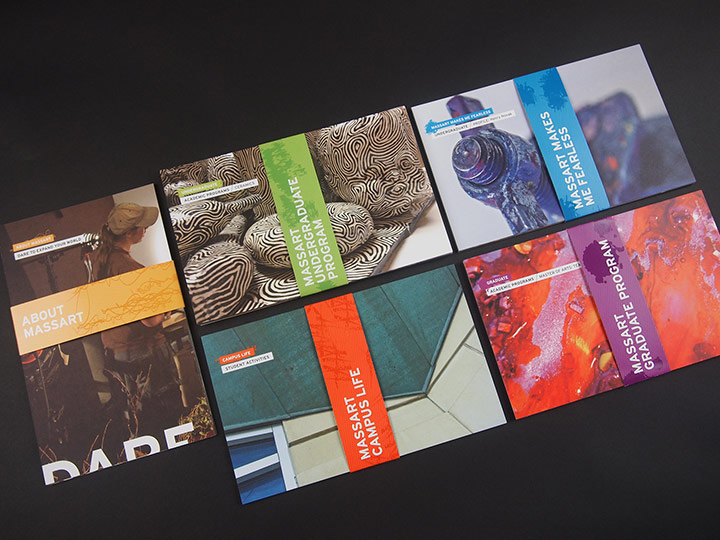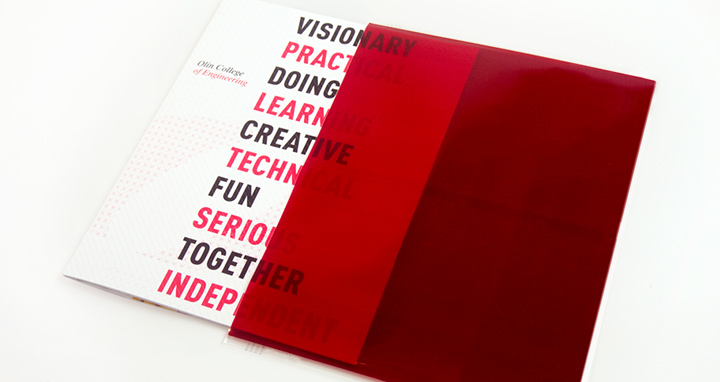You have /5 articles left.
Sign up for a free account or log in.
Now that you have an understanding of the process behind building a compelling brand, have gotten calibrated through thoughtful research, have crafted resonant messaging, and have developed a visual toolbox, it’s time to take a closer look at how strategic choices around methods and materials will increase the impact of your print communications.
The print piece you’ve been working on for weeks is finally done. Your copy reflects key facets of your messaging, and keeps the focus on what your intended audience cares about most. Your design makes compelling use of your visual toolbox, reinforcing your messaging through thoughtfully chosen type, color, and imagery. All that’s left to do now is to ship your files off to the printer and hope for the best, right? On the contrary, you’ve got another creative opportunity to take advantage of—unless you want to miss out on the chance to connect with your recipients in a deeply tactile and memorable way. A new viewbook for MassArt took advantage of clever production choices to create a unique “user experience.” The book was actually five suits of cards (each captured in a belly band) placed in an envelope together. Each suit featured a different approach to imagery and unique colors and graphic elements that conveyed the experimental, creative, and iconoclastic ethos of the institution.
On the contrary, you’ve got another creative opportunity to take advantage of—unless you want to miss out on the chance to connect with your recipients in a deeply tactile and memorable way. A new viewbook for MassArt took advantage of clever production choices to create a unique “user experience.” The book was actually five suits of cards (each captured in a belly band) placed in an envelope together. Each suit featured a different approach to imagery and unique colors and graphic elements that conveyed the experimental, creative, and iconoclastic ethos of the institution.
The methods and materials you use to bring your designs to life are a critical component in creating a successful print piece. “Methods and materials” refers to production elements like size and format; paper and ink; printing method/press; binding, folding, and cutting; and special processes like embossing and foil stamping. The choices you make will shape how your work will be received and perceived, and should ideally continue the process of building your brand.
Sending a message—for better or for worse
Your production values can send a message—and not always the message you mean to send. For example:
- A beautiful, evocative design printed on cheap, too-glossy paper with a printing process that lacks “pop” undermines both the integrity and impact of piece as a whole, leaving your recipient wondering why they—and your brand—weren’t worth the investment; or
- An emergency fundraising pitch delivered on thick, expensive paper with intricate (and pricey!) embossing may raise questions about how you’re stewarding your funds. Your donors deserve quality print communications that give them a clear sense of who you are and what you care about, but a more modest approach to production lets them know you’ve got your priorities in order.
But it’s not just about the money you spend (or don’t spend): it’s about making intentional, thoughtful choices that complement and enhance your design and align properly with the purpose of your piece.
Striking the right balance
You want to ensure your production details align well with your design, purpose, and audience—but how do you wade through all the choices available to you to get to the right combination? Ask yourself the following questions to get the ball (or the presses) rolling:
- How should this piece reflect my brand? First and foremost, decide how your piece will align with or contrast against the design and production of rest of your communications. If you’re eager to do something very different than you’ve done before, take a moment to consider why: are you trying to send a new message or to connect with a new audience? Both can be valid reasons for doing something more unexpected, but the choice to depart from your system in some way deserves careful thought.
- How should this piece relate to the rest of my communications? If you’re using your print piece as part of a suite or campaign that includes your digital presence or social media, there should be a definite relationship between what’s in your recipient’s hand, and what’s on their screen.
- What’s my budget? This might seem like an obvious question, but it’s easy to get caught up in a great idea and then have to start back at square one when your big idea is bigger than your budget. Consider all the different costs that could correlate with your creative production ideas, and ensure you’ll have the funds to execute them beautifully.
- Who is my audience? The average academic institution speaks to a wide range of audiences in a wide range of ways: a gala invite for your donors and supporters; an acceptance packet for your incoming class; a magazine that shares alumni stories; a poster hoping to snag the attention of a passing high school senior on a bulletin board at their school. Each piece you produce has a unique set of recipients who expect different production values and levels of engagement and impact—and it’s up to you to figure out what’s best for each one.
- What are my logistics and what’s my context? How will the piece be distributed? If you’re mailing it out, consider how you’ll package it, and how the size and weight will affect your postage costs. If you’re sending it out with your traveling admissions counselors, you’ll want to provide them with a communications tool that’s easy to store and carry. If you’re planning to place it on a table at an awards dinner, consider how it can fit seamlessly into the table-scape (without knocking over the saltshaker).
Once you’ve got your answers in hand, you’re ready to decide which production choices—whether subtle or bold—best support your design, and convey your institutional personality.
 For example, a recent Olin College viewbook was housed in a red envelope that “hid” several of the bold words on the cover at first glance, leading to a moment of discovery as soon as the entire cover was revealed. This choice served as an evocative first step in conveying the unique and innovative nature of the Olin experience, its community, and its alumni.
For example, a recent Olin College viewbook was housed in a red envelope that “hid” several of the bold words on the cover at first glance, leading to a moment of discovery as soon as the entire cover was revealed. This choice served as an evocative first step in conveying the unique and innovative nature of the Olin experience, its community, and its alumni.
Take advantage of every opportunity to reinforce your brand
As you work through all the different questions, challenges, and choices inherent in producing your print pieces, keep your brand at the forefront of your mind. Just as with your messaging and design, your selections around paper, ink, printing methods, binding, and more will contribute to how your recipients see you—and how compelled they feel to engage with you once your piece is in their hands.
Michael Eads (michael@sametz.com) is principal and director of production at Sametz Blackstone Associates, a Boston-based brand consultancy that integrates brand, editorial, and digital strategy with design and digital media.
This post is the fifth in a series of eight by senior staff at Sametz Blackstone Associates to help you craft an authentic, differentiating verbal and visual brand—to build interest, comprehension, enrollment, and support.








